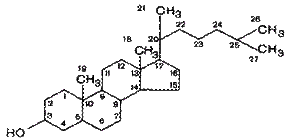Phosphatidylcholine
2. Sphingolipids (sphingomyelins) - Lipids containing amino alcohol sphingosine.
 ceramide
ceramide
3. Glycolipids- carbohydrate compounds in which the carbohydrate part of the covalently bound lipid.
 galactozilseramide
galactozilseramide
A characteristic feature of the molecules of phospholipids and glycolipids is their amphipathic charactere, one end of the molecule is hydrophobic and the other is hydrophilic.
4. Steroidsare represented by cholesterol:

Proteins may be completely or partially embedded in the membrane (intrinsic, or integral proteinsand semi integral proteins) or placed on its surface (extrinsic, or peripheral proteins). Sites of protein, which are turned into the extracellular medium, may be glycosylated.
The protein composition of different membranes is different. Membrane proteins perform different functions: structural proteins, enzymes, proteins carrying out the transmembrane transport of metabolites, hormone receptors.
Biological membranes are composed of a lipid bilayer of the small thickness (6 - 10 nm). The membranes are asymmetric in their original structure, which provides the gradient of the curvature and the spontaneous formation of closed structures.
Typically, plasma membrane proteins are highly glycosylated from the extracellular medium. Intracellular membranes contain few glycoproteins and glycolipids and are characterized by lower microviscosity. Therefore, they can form small organelles.
Cell membranes form significant limitations to the transfer of substances. The main obstacle is the hydrophobic region of the membrane. However, membranes are not impermeable structures. One of the main functions of membranes is regulation of substances transfer.

Fig. 15. The structure of the biological membrane
Дата добавления: 2018-09-24; просмотров: 352;
